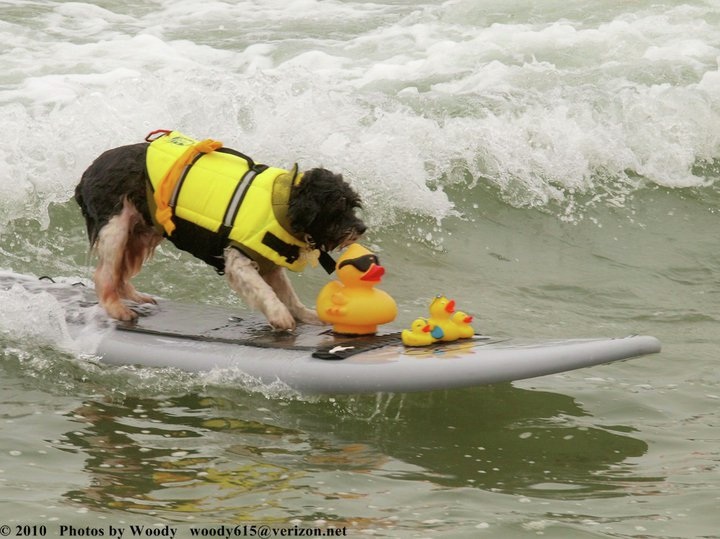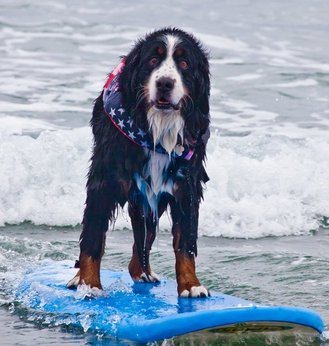Kay DeLoach asks,
Hi Nani, my surfing dog Joey is Westie. I have a question for you. Some of the smaller dogs have a duck or something affixed to the surf board to keep the dogs from jumping, I assume.
Do you know how they attached the duck? Thanks!!!
Hi Nani, my surfing dog Joey is Westie. I have a question for you. Some of the smaller dogs have a duck or something affixed to the surf board to keep the dogs from jumping, I assume.
Do you know how they attached the duck? Thanks!!!
Hi Kay,
Yes, little Toby, the Shih Tzu mix, has different size Rubber Ducks on his surfboard primarily to keep him from running up to the front of his surfboard. For him, it works. You can see some photos of him at: http://www.socalsurfdogs.com/toby.html
He does not use them all the time, but while learning to surf, they seemed to help.
Sometimes he would use them in competitions to get the attention of the judges. This works!
(When dogs run to the front of the surfboard, it causes the nose of the surfboard to go underwater and the result is the dog is catapulted into the water. This is called Pearling. This is not a good thing!)
It is a very typical problem with many dogs (especially new surf dogs) because they’re not really very comfortable on the surfboard and just want to get off. This can be stopped with any one, or all, of the following methods:
1. Before you go to the beach, start by placing your soft-top boogie board or soft-top surfboard in the back yard or in the house and work on getting your dog to get up onto the board by themselves.
Feed them on the board. No treats given unless they are on the board.
No walks until they get on the board first.
No playing with their favorite toy until they are on the board.
They need to understand that this is a safe, fun place to be. (While you’re at it, work on getting them to stand in the back 1/3rd of the surfboard over the fins.)
As with all the following methods, it may take awhile. Be patient. Keep trying. No harsh words or punishment. Sooner or latter the light will come on.
2. Next, start by floating your dog on a soft-top boogie board, soft-top surfboard or soft-top paddle board in a pool, a lake or bay. The owner can walk or swim along side or you can get on the board with the dog. Again, you want to slowly get them to understand this is a fun thing and a safe place to be. You can also push them off the board (gently please) and help them back up. Take your time, be patient and always lather on the praise. (Never harsh words or punishment)
3. When you do eventually go into the surf, do not go out very far. Start by surfing your dog in a few very small waves. Ease them into the waves slowly….no jerky or sudden moves.
4. If they still run to the nose, you can try to place a few rubber toys on the surfboard, so they cannot easily run up to the nose. Glue some Velcro onto the surfboard and the other half of the Velcro onto the rubber toys. Make sure the surface is clean and dry before you attempt to glue on the Velcro. Gorilla Glue seems to work pretty well. Read the directions before you try.
5. If you’re still having this issue, try surfing them backwards a few times. (Again, make sure they are standing in the back 1/3 of the surfboard.)
6. I don’t recommend it, but some people have had success (only while learning) by leashing their dog on a short leash (secured to the back of the surfboard) that keeps them in the back 1/3rd of the surfboard. NEVER EVER hook the leash to their collar. Only attach the leash to the handle on their life jacket.
I personal have seen owners that had to leash their dogs for a few years before they could stop using the leash.
7. If you still can’t get them to stay on the surfboard after all of these methods……then they are probably one of the many dogs that don’t want to surf. (Please don’t force them. There are so many other things you can do with your best friend)
My dogs won’t chase a ball. No matter what I do, they have no interest. So, we don’t throw the ball for them any more. Now we surf.
You can get more tips and help with teaching your dog to surf at:
http://www.socalsurfdogs.com/teach-your-dog-to-surf.html
Yes, little Toby, the Shih Tzu mix, has different size Rubber Ducks on his surfboard primarily to keep him from running up to the front of his surfboard. For him, it works. You can see some photos of him at: http://www.socalsurfdogs.com/toby.html
He does not use them all the time, but while learning to surf, they seemed to help.
Sometimes he would use them in competitions to get the attention of the judges. This works!
(When dogs run to the front of the surfboard, it causes the nose of the surfboard to go underwater and the result is the dog is catapulted into the water. This is called Pearling. This is not a good thing!)
It is a very typical problem with many dogs (especially new surf dogs) because they’re not really very comfortable on the surfboard and just want to get off. This can be stopped with any one, or all, of the following methods:
1. Before you go to the beach, start by placing your soft-top boogie board or soft-top surfboard in the back yard or in the house and work on getting your dog to get up onto the board by themselves.
Feed them on the board. No treats given unless they are on the board.
No walks until they get on the board first.
No playing with their favorite toy until they are on the board.
They need to understand that this is a safe, fun place to be. (While you’re at it, work on getting them to stand in the back 1/3rd of the surfboard over the fins.)
As with all the following methods, it may take awhile. Be patient. Keep trying. No harsh words or punishment. Sooner or latter the light will come on.
2. Next, start by floating your dog on a soft-top boogie board, soft-top surfboard or soft-top paddle board in a pool, a lake or bay. The owner can walk or swim along side or you can get on the board with the dog. Again, you want to slowly get them to understand this is a fun thing and a safe place to be. You can also push them off the board (gently please) and help them back up. Take your time, be patient and always lather on the praise. (Never harsh words or punishment)
3. When you do eventually go into the surf, do not go out very far. Start by surfing your dog in a few very small waves. Ease them into the waves slowly….no jerky or sudden moves.
4. If they still run to the nose, you can try to place a few rubber toys on the surfboard, so they cannot easily run up to the nose. Glue some Velcro onto the surfboard and the other half of the Velcro onto the rubber toys. Make sure the surface is clean and dry before you attempt to glue on the Velcro. Gorilla Glue seems to work pretty well. Read the directions before you try.
5. If you’re still having this issue, try surfing them backwards a few times. (Again, make sure they are standing in the back 1/3 of the surfboard.)
6. I don’t recommend it, but some people have had success (only while learning) by leashing their dog on a short leash (secured to the back of the surfboard) that keeps them in the back 1/3rd of the surfboard. NEVER EVER hook the leash to their collar. Only attach the leash to the handle on their life jacket.
I personal have seen owners that had to leash their dogs for a few years before they could stop using the leash.
7. If you still can’t get them to stay on the surfboard after all of these methods……then they are probably one of the many dogs that don’t want to surf. (Please don’t force them. There are so many other things you can do with your best friend)
My dogs won’t chase a ball. No matter what I do, they have no interest. So, we don’t throw the ball for them any more. Now we surf.
You can get more tips and help with teaching your dog to surf at:
http://www.socalsurfdogs.com/teach-your-dog-to-surf.html



 RSS Feed
RSS Feed